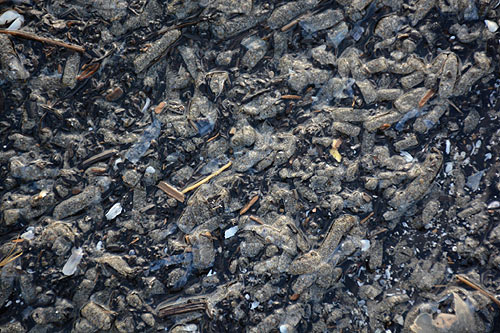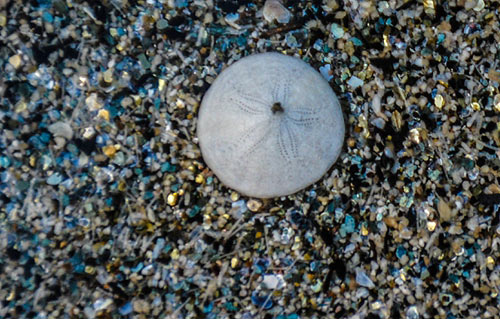Unusual for July, N. Oregon Coast Ocean Burp Brings Numerous Critters
Published 07/07/2016 at 7:11 PM PDT - Updated 07/07/2016 at 7:31 PM PDT
By Oregon Coast Beach Connection staff

(Seaside, Oregon) – Gobs of interesting stuff washed up onshore on the north Oregon coast yesterday, in what is commonly called an “ocean burp.” The technical term of all this is detritus, and it means the ocean is casting some interesting objects from the depths onto the shores – things you don’t normally find on the beaches. (All photos Tiffany Boothe, Seaside Aquarium).
Tiffany Boothe of Seaside Aquarium snapped a good number of photographs of this enormous debris field at the southern end of Seaside.
“There was a small ocean burp at the Cove yesterday,” Boothe said. “It was mostly composed of small woody debris, crab molts, tube worm casings, and some small shells.”

Boothe said that coming across one of these is a beachcomber's dream. These small debris fields are usually composed of small bark chips, shells, large tubeworm casings, hermit crabs, algae, kelp, and sometimes even skate egg casings. They usually occur because of a local upwelling.
“An upwelling is an oceanographic phenomenon that involves wind-driven motion of denser, cooler, and usually nutrient-rich water towards the ocean surface, replacing the warmer, usually nutrient-depleted surface water,” Boothe said.
This juggling of water from the bottom of the ocean to the surface often lifts debris sitting on the seafloor into the water column. As the tide comes in the debris is cast onto shore.
“At the Seaside Aquarium, we fondly refer to these events as ‘ocean burps,’ " Boothe said.

These ocean burps occur under some very exact conditions, when the right mix of storms or wind happen along with the right kind of ocean currents. Having an ocean burp in summer is somehwat unusual as it usually requires wilder conditions than normally happen in July.

In the series, you also see a jellyfish called a water jelly, scientific name Aequorea victoria. Water jellies are found all over the western American continent – from Alaska, down through Canada, to the Oregon, Washington and California coasts. They tend to be more common farther north in British Columbia and Washington, so it's not too often that they show up here..
They have quite an interesting design: while laying flat in the sand and spread out, you'll see the radial spokes. They can have as many as 60, and can get up to seven inches in diameter. Even more surprising is that they are bioluminescent, meaning they glow when touched or disturbed. This only happens when they're still alive, however. Oregon Coast Hotels for this - Where to eat - Maps - Virtual Tours



More About Oregon Coast hotels, lodging.....
More About Oregon Coast Restaurants, Dining.....
Cannon Beach Lodging
Nehalem Bay Lodgings
Manzanita Hotels, Lodging
Three Capes Lodging
Pacific City Hotels, Lodging
Lincoln City Lodging
Depoe Bay Lodging
Newport Lodging
Waldport Lodging
Yachats Lodging
Oregon Coast Vacation Rentals
Oregon Coast Lodging Specials
LATEST Related Oregon Coast Articles
Likely just before dawn best hour but peak happens during daylight. Weather
Dark Sky Week is Prime Along Oregon Coast: Where and Where Not to Go
General guide to dark sky viewing from south to north coast. Astronomy
Sizable Price Drop, Deals in Lincoln City During Quiet of April on Central Or...
20 perc off at A1 Vacation Rentals across its roster, including Gleneden Beach. Lincoln City specials
Upcoming S. Oregon Coast Events Include Gem Show, History: Coos Bay, Bandon
May 6 talk at Coos History Museum, Mayfly Fest May 17, Bandon Rock / Gem Show June 7,8
Washington Coast Cleanup on April 19 - Coinciding with Oregon Coast's SOLVE E...
From the Puget Sound to Long Beach, alongside Oregon's cleanup. Washington coast events, Seaside events
Astoria's Riverwalk Gets New Lighting, More N. Oregon Coast Roadwork
Delays coming this summer, but the riverwalk has a new look. Seaside, Cannn Beach
April Gets Even Cheaper Midweek at Depoe Bay, Lincoln City: Oregon Coast Deals
Off-season rates plus more at Keystone Vacation Rentals. Depoe Bay lodging specials, Lincoln City hotel reviews, Newport hotel reviews
Washington Coast Begins Week of Clam Digs, April 12 Through 18
Long Beach, Twin Harbors, Mocrocks and Copalis at different times. Washington coast events
Back to Oregon Coast
Contact Advertise on BeachConnection.net
All Content, unless otherwise attributed, copyright BeachConnection.net Unauthorized use or publication is not permitted














































